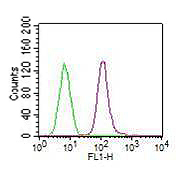anti-TLR7 (human) mAb (ABM2C27) (FITC)
| Code | Size | Price |
|---|
| AG-20T-0306F-C100 | 100 ug | £355.00 |
Quantity:
Prices exclude any Taxes / VAT
Overview
Antibody Clonality: Monoclonal
Regulatory Status: RUO
Target Species: Human
Application: Fluorescence-activated cell sorting (FACS)
Shipping:
+4°C
Storage:
4°C
Images
Documents
Further Information
Alternate Names/Synonyms:
Toll-like Receptor 7
Concentration:
0.2mg/ml
EClass:
32160000
Form (Short):
liquid
Formulation:
Liquid. In 10mM TRIS containing 150mM NaCl and 0.05% sodium azide.
Handling Advice:
Do not freeze.Protect from light.
Immunogen:
Recombinant human TLR7 protein (aa 500-900).
Labels - Conjugates:
FITC
Long Description:
Monoclonal Antibody. Recognizes human TLR7. Isotype: Mouse IgG1kappa. Clone: ABM2C27. Applications: FACS. Liquid. In 10mM TRIS containing 150mM NaCl and 0.05% sodium azide. TLR7 (Toll-like Receptor 7) is a member of the TLR (Toll-like receptor) family that plays a fundamental role in pathogen recognition and activation of innate immunity. TLR7 is a nucleotide-sensing TLR. TLR7 and TLR8 recognize single-stranded RNA (ssRNA) sequences containing GU-rich or poly-U sequences as their natural ligands, and they are also activated by synthetic small-molecular-weight compounds of the imidazoquinoline family. Both TLR7 and TLR8 signal via MYD88 and TRAF6, leading to NF-kappaB and antiviral factor, such as IRF family activation, cytokine secretion and the inflammatory response. They are localized intracellularly to endosomal membranes and act as potent activators of innate immune responses upon viral infection. The TLR7 gene is predominantly expressed in lung, placenta and spleen, and lies in close proximity to TLR8 on chromosome X. TLR7 has been shown to play a significant role in the pathogenesis of autoimmune disorders such as Systemic Lupus Erythematosus (SLE) as well as in the regulation of antiviral immunity. Recently, small molecule TLR7/8 agonists have demonstrated potential as vaccine adjuvants, since they directly activate APCs and can enhance both humoral and cellular immune responses, especially Th1 responses. This makes the TLR7/8 signaling pathways interesting therapeutic targets.
Package Type:
Plastic Vial
Product Description:
TLR7 (Toll-like Receptor 7) is a member of the TLR (Toll-like receptor) family that plays a fundamental role in pathogen recognition and activation of innate immunity. TLR7 is a nucleotide-sensing TLR. TLR7 and TLR8 recognize single-stranded RNA (ssRNA) sequences containing GU-rich or poly-U sequences as their natural ligands, and they are also activated by synthetic small-molecular-weight compounds of the imidazoquinoline family. Both TLR7 and TLR8 signal via MYD88 and TRAF6, leading to NF-kappaB and antiviral factor, such as IRF family activation, cytokine secretion and the inflammatory response. They are localized intracellularly to endosomal membranes and act as potent activators of innate immune responses upon viral infection. The TLR7 gene is predominantly expressed in lung, placenta and spleen, and lies in close proximity to TLR8 on chromosome X. TLR7 has been shown to play a significant role in the pathogenesis of autoimmune disorders such as Systemic Lupus Erythematosus (SLE) as well as in the regulation of antiviral immunity. Recently, small molecule TLR7/8 agonists have demonstrated potential as vaccine adjuvants, since they directly activate APCs and can enhance both humoral and cellular immune responses, especially Th1 responses. This makes the TLR7/8 signaling pathways interesting therapeutic targets.
Purity:
Protein G purified.
Specificity:
Recognizes human TLR7.
Transportation:
Non-hazardous
UNSPSC Category:
Primary Antibody Conjugates
UNSPSC Number:
12352203
Use & Stability:
Stable for at least 6 months after receipt when stored at +4°C.



